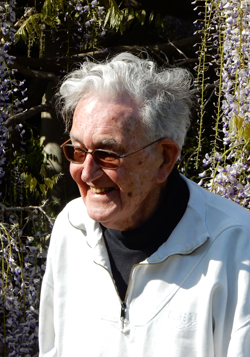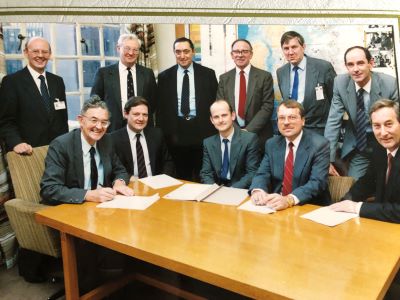 Gareth Hughes was born in Mumbles and educated at Swansea grammar school and Swansea University. He joined the Geological Society in 1955 and became a senior Fellow in 2005. Gareth was also a Fellow of the Energy Institute and a member of the American Association of Petroleum Geologists, Society of Petroleum Engineers, and The Gower Society. He passed away aged 90 following prostate cancer.
Gareth Hughes was born in Mumbles and educated at Swansea grammar school and Swansea University. He joined the Geological Society in 1955 and became a senior Fellow in 2005. Gareth was also a Fellow of the Energy Institute and a member of the American Association of Petroleum Geologists, Society of Petroleum Engineers, and The Gower Society. He passed away aged 90 following prostate cancer.
Left: I.W. Gareth Hughes. Image courtesy of Caroline Clark.
African oil exploration
In 1958, Gareth moved to Nigeria to work as a wellsite petroleum engineer. During his four years in Owerii and Port Harcourt, Shell found enough oil in the Niger Delta to continue oil production in Nigeria. Gareth pioneered first attempts at using very narrow seismic profiles around their discovery wells. In 1984, Gareth was commissioned to drill wells in Mogadishu by World Bank and Keplinger McCord Lewis; however, these wells were relatively dry, failing to bring the Somalians a similar fortune.
Mapping
From May 1962, Gareth worked across Venezuela, travelling to Maracaibo, Bachaquero, and Lagunillas. Gareth worked on unitisation with Creole Petroleum Company of Venezuela (part of Exxon) on Lake Maracaibo wells. In 1964, he produced cross sections of Lake Maracaibo’s wells using one of the first IBM System/360 computers in Caracas, using thousands of punch cards that took 12 hours to print. From 1966, Gareth oversaw all geology for The Shell Company of Qatar. During this time, Gareth ran detailed seismic surveys around wells and studied the stratigraphy of the Arabian Gulf, which allowed Gareth to identify a large deep structure extending northwards to the Qatar/Iran border, which later became the largest gas field in the world.
North Sea exploration
After working in Lagos, Nigeria, Gareth began exploring the North Sea. As Conoco’s only production geologist in London, Gareth represented them for unitisation on the Thistle oil field; worked in Stavanger on Norwegian concessions; and oversaw drilling in Aberdeen, Scotland, and Kavala, Greece. He continued in the commercial sector as an exploration manager with Amerada from 1976 until 1982, when he became managing director of the North Sea for Sun Oil for a short period, bringing the Balmoral oil field into production.
Gareth joined the Civil Service Department of Energy in 1988 as director of the exploration and appraisal development unit. Gareth negotiated the field limits of the Statfjord oil field, located between Scotland and Norway, for the UK and Norwegian governments.
As director of petroleum engineering, Gareth covered all onshore and maritime UK waters and, as the most senior geologist, in 1990, he made final decisions on defining the borders of different oil fields, including the North Sea Guillemot field submitted by Shell. As chair of offshore exploration, he was responsible for the UK authorisation of the Kerr-McGee oil rig, a new type of rig that was built in Newcastle ahead of being built in the US.
Gareth is survived by his wife, 2 daughters, and 2 grandsons.
By Gareth Hughes
The full version of this obituary appears below - Editor.
I.W. Gareth Hughes (1933 – 2024)
Petroleum engineer who contributed significantly to oil exploration in the Nigerian Delta, United Emirates, and North Sea.
 Gareth Hughes was born in Mumbles and educated at Swansea grammar school and Swansea University. He joined the Geological Society in 1955 and became a senior Fellow in 2005. Gareth was also a Fellow of the Energy Institute and a member of the American Association of Petroleum Geologists, Society of Petroleum Engineers, and The Gower Society. He passed away aged 90 following prostate cancer.
Gareth Hughes was born in Mumbles and educated at Swansea grammar school and Swansea University. He joined the Geological Society in 1955 and became a senior Fellow in 2005. Gareth was also a Fellow of the Energy Institute and a member of the American Association of Petroleum Geologists, Society of Petroleum Engineers, and The Gower Society. He passed away aged 90 following prostate cancer.
Left: Gareth Hughes (leftmost, front row) with colleagues.
Outdoor explorer
Gareth’s love of the outdoors and exploration started young; at only 15, he joined The Gower Society. He assisted Denis Grenfield in cleaning the gardens of Swansea Museum, the then-headquarters of The Gower Society. As a summer job, Gareth mapped many outside toilets for the Ordnance Survey, as well as working on the docks.
Despite his family’s financial struggles due to his father’s blindness, Gareth studied mathematics at University College, Swansea through the King George V scholarship. After discovering geology in his first year of study, he transferred subjects. Gareth was awarded a Shell scholarship to study oil technology, receiving a Diploma of Imperial College, the equivalent of a Master’s, in 1956. In 1957, he started Shell’s petroleum engineering training course in The Hague, Netherlands, and married Joyce Rogers, his life-long partner.
African oil exploration
In 1958, Gareth moved to Nigeria to work as a wellsite petroleum engineer. During his four years in Owerii and Port Harcourt, Shell found enough oil in the Niger Delta to continue oil production in Nigeria. Gareth pioneered first attempts at using very narrow seismic profiles around their discovery wells. His wife joined him taking a 6-week long boat journey, giving birth to their first daughter by caesarean section – a first in Owerii. In 1984, Gareth was commissioned to drill wells in Mogadishu by World Bank and Keplinger McCord Lewis; however, these wells were relatively dry, failing to bring the Somalians a similar fortune. However, Gareth still enjoyed transferring knowledge to budding graduates.
Mapping
From May 1962, Gareth worked across Venezuela, travelling to Maracaibo, Bachaquero, and Lagunillas. Gareth worked on unitisation with Creole Petroleum Company of Venezuela (part of Exxon) on Lake Maracaibo wells. Although the US law of capture had been applied, where wells had to be at least 200 metres from a block boundary, the distances from the Shell block varied from 50 to 400 metres. Gareth and his team determined the cause of this discrepancy: Shell’s surveyors had not accounted for the Earth’s curvature when measuring these distances, which actually made a significant difference over the large area of Lake Maracaibo. In 1964, he produced cross sections of Lake Maracaibo’s wells using one of the first IBM System/360 computers in Caracas, using thousands of punch cards that took 12 hours to print.
From 1966, Gareth oversaw all geology for The Shell Company of Qatar. During this time, Gareth ran detailed seismic surveys around wells and studied the stratigraphy of the Arabian Gulf, which allowed Gareth to identify a large deep structure extending northwards to the Qatar/Iran border, which later became the largest gas field in the world.
North Sea exploration
After working in Lagos, Nigeria, Gareth began exploring the North Sea. As Conoco’s only production geologist in London, Gareth represented them for unitisation on the Thistle oil field; worked in Stavanger on Norwegian concessions; and oversaw drilling in Aberdeen, Scotland, and Kavala, Greece. He continued in the commercial sector as an exploration manager with Amerada from 1976 until 1982, when he became managing director of the North Sea for Sun Oil for a short period, bringing the Balmoral oil field into production.
Gareth joined the Civil Service Department of Energy in 1988 as director of the exploration and appraisal development unit. Gareth negotiated the field limits of the Statfjord oil field, located between Scotland and Norway, for the UK and Norwegian governments.
As director of petroleum engineering, Gareth covered all onshore and maritime UK waters and, as the most senior geologist, in 1990, he made final decisions on defining the borders of different oil fields, including the North Sea Guillemot field submitted by Shell. As chair of offshore exploration, he was responsible for the UK authorisation of the Kerr-McGee oil rig, a new type of rig that was built in Newcastle ahead of being built in the US.
Gareth visited offshore platforms and rigs and kept up to date with modern developments, such as crane lift barges, which influenced pipeline developments in the North Sea. As chair of offshore exploration, he was responsible for the UK authorisation of the Kerr-McGee oil rig, a new type of rig that was built in Newcastle ahead of being built in the US.
Retirement
Gareth became semi-retired in 1994, then fully retired in the late-1990s after a brief spell of consulting. His love of travelling, piqued as a boy by a black and white etching of Mayan ruins in a second-hand magazine, followed him through his life. His enthusiasm took him and his family to many lands furnished with history and geological intrigue. Despite this, he never lost his love for his hometown of Mumbles and the Gower coast.
Gareth’s near blindness in the 2000s did not stop his gardening, DIY, travelling, and walking. He was always acutely aware of his surroundings and admiring nature and geological advances. He is survived by his wife of 67 years, 2 daughters, and 2 grandsons, Robert and (Dr) James, who, along with his with friends, sorely miss his selflessness, modesty, dry sense of humour, enthusiasm, curiosity, knowledge, zest for problem solving and life, as well as his ceaseless wonder of the mountains and rocks.
By Gareth Hughes